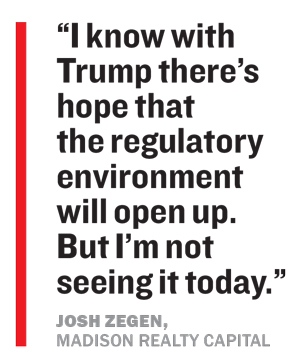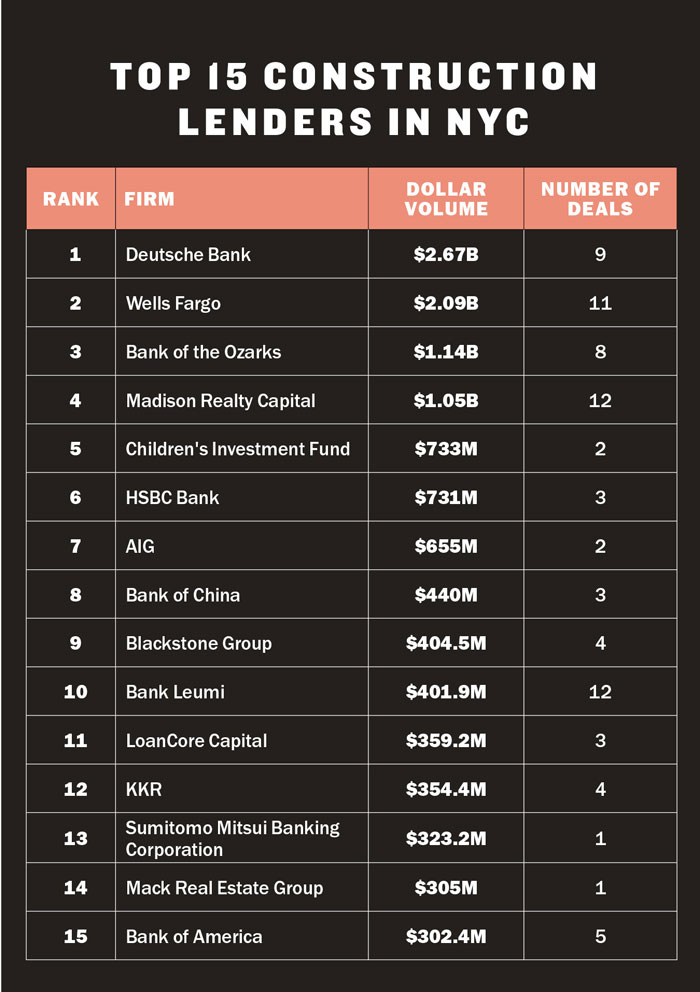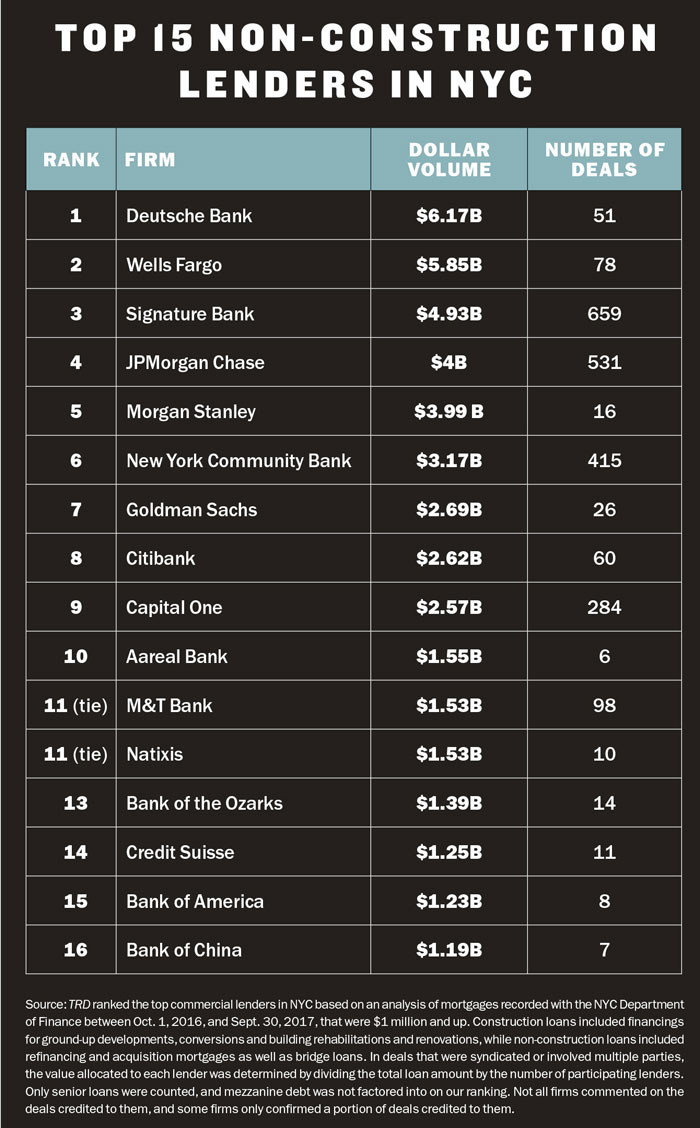In early June, New York real estate investor and lender Josh Zegen got a tip that Lou Ceruzzi was looking for a massive construction loan to fund his 72-story luxury condo tower at 138 East 50th Street. The structure already stood several stories tall, and Ceruzzi needed money quickly to avoid delays on the site.
Zegen smelled an opportunity.
For the past 13 years, his firm Madison Realty Capital had built a reputation as a daredevil debt shop willing to take on the kinds of risky, high-yield deals that banks won’t touch. It was not, however, known as a financer of Manhattan skyscrapers. And Zegen was out to change that.
He called Ceruzzi and gave his pitch: Madison might not be the cheapest lender in the city (the firm’s interest rates average between 8 and 11 percent), but it could close a large loan within 30 days.
“A lot of the people we were competing with wanted to provide the [mezzanine loan], and Ceruzzi still had to think about the senior loan,” Zegen recalled. He was willing to do both.
On July 1, the developer and Madison signed an agreement for $300 million in construction financing, Zegen said. On July 31, the deal closed, marking the largest loan Madison had ever done. Ceruzzi passed away a few months later at age 64 but his firm remains active and the condo tower is still in the works.
Related: Behind the complicated financing of One Vanderbilt
If anyone thought the election of Donald Trump and a Wall Street-friendly Congress would instantly change the balance of power in New York’s commercial real estate market, the 138 East 50th Street deal offers a reality check.
“I know with Trump there’s hope that the regulatory environment will open up,” Zegen said. “But I’m not seeing it today.”
 Indeed, nonbank lenders have jumped on the many opportunities in New York real estate spurred by the regulatory constraints on U.S. banks since the creation of Dodd-Frank and Basel III.
Indeed, nonbank lenders have jumped on the many opportunities in New York real estate spurred by the regulatory constraints on U.S. banks since the creation of Dodd-Frank and Basel III.
And the past year was no different, according to The Real Deal’s ranking of the city’s top commercial real estate lenders. While traditional banks, and mostly domestic ones, dominated non-construction lending, a handful of alternative debt providers, including Madison, Children’s Investment Fund, Blackstone and AIG, rose high among the top construction lenders.
Private real estate debt funds, for example, raised $20 billion globally in 2016, and their combined dry powder (or unspent capital commitments) reached a record level of $46 billion in the third quarter of 2017, per the alternative asset data provider Preqin.
“You have people trying to kill each other for business,” said Dustin Stolly, co-head of Newmark Knight Frank’s debt group. He noted that the lending environment last year “was as aggressive as I’ve seen in my career, with the exception of the run-up to the credit crisis.”
Mortgage REITs, insurance firms, private funds and foreign lenders are pumping more debt into the New York market than ever before, according to industry sources. Yet despite the added competition, industry players interviewed for this story to said the lending climate in the city is healthy.
Following two years of increased investment in Manhattan trophy properties and record-high property prices, commercial real estate sales fell by 44 percent in 2017 in New York, according to Cushman & Wakefield.
As sales fell, capital shifted over to debt markets, said Greg Reimers, Northeast market manager at JPMorgan Chase’s real estate banking group. “It’s a great time to borrow money,” he said. “Excess liquidity is driving rates to the bottom.”
Tallying the titans
For this month’s ranking, TRD pulled commercial mortgages from the city’s Department of Finance, filed between October 2016 and September 2017, to see which firms were the most active construction and non-construction lenders in that time frame.
Non-construction debt includes refinancing and acquisition mortgages as well as bridge loans. Construction debt includes loans for ground-up developments, conversions and building rehabilitations and renovations. Since most mezzanine loans are not recorded in public records, subordinate debt was not accounted for in the ranking.
Deutsche Bank topped both lists with $6.17 billion in non-construction mortgages across 51 deals and $2.67 billion in construction loans across nine deals. When the German financial giant agreed in December 2016 to a $7.2 billion settlement over its role in the subprime mortgage crisis, some observers, including TRD, wondered what might happen if it retreated from the market.
But it turns out the bank never missed a beat. It had a hand in several major syndicates last year, including the $1.75 billion financing of HNA Group’s 245 Park Avenue acquisition in April and a $1.075 billion refinancing of SL Green Realty and Vornado Realty Trust’s 280 Park Avenue.

Wells Fargo wasn’t far behind, taking the No. 2 spots in both the non-construction and construction rankings with $2.09 billion across 11 deals and $5.85 billion across 78 deals, respectively. Like Deutsche Bank, the San Francisco-based firm had its fair share of negative news coverage amid reports that it created fraudulent checking and savings accounts on behalf of its clients without their consent. But the scandal seems to have had virtually no impact on the bank’s commercial real estate lending group, which was part of a consortium that funded Related Companies and Mitsui Fudosan’s 50 Hudson Yards with a $1.5 billion construction loan.
Meanwhile, there was no overlap among the remaining top five construction and non-construction lenders. Signature Bank clocked in at No. 3 on the non-construction lender list, making it the top regional bank on the ranking, with $4.93 billion in deals. The bank issued by far the most loans of all of the firms, with a total of 659.
JPMorgan Chase followed at No. 4 with $4 billion in non-construction financing across 531 loans. On first sight, the financial giant is proof that traditional banks still matter in New York’s commercial real estate market. In May, the bank financed HNA Group’s acquisition of 245 Park Avenue with a $1.75 billion mortgage — the year’s single largest acquisition loan. It also gave Extell Development a $900 million construction loan for its Central Park Tower project and Harry Macklowe an $850 million loan to fund his One Wall Street condo conversion, among other deals.
But look more closely and the picture gets complicated. It was JPMorgan’s investment banking unit, rather than the commercial banking division, that originated the two construction loans. It held on to part of the loans but sold the bulk to private investors such as private equity debt funds, according to sources. Although the loans were issued by a bank, it was mostly nonbank money that ultimately funded them.
In contrast to Signature and JPMorgan, Morgan Stanley, which ranked No. 5 in non-construction lending with $3.99 billion, issued just 16 loans. Morgan Stanley played a key role in the single biggest debt deal of the year, leading a consortium of banks in the $2.3 billion refinancing of the GM Building in April.
Among the top five construction lenders, Bank of the Ozarks ranked No. 3 with $1.14 billion across eight deals. The midsize firm based in Little Rock, Arkansas, has become one of the most prolific financers of ground-up condo projects in NYC as many other traditional lenders have pulled back from that market.
And while three banks led the list of top construction lenders, seven of the 15 firms were nonbanks. Madison Realty Capital — which according to sources launched a $1 billion-plus real estate debt fund in 2017 — took the No. 4 spot with $1.05 billion across 12 deals.
And the London-based hedge fund Children’s Investment Fund continued its run as a financer of Manhattan’s big-ticket condo developments, taking the No. 5 spot with $733 million across just two loans. While the firm agreed to fund HFZ Capital Group’s High Line project at 76 11th Avenue to the tune of $1.2 billion — through its affiliate Talos Capital — a $595 million senior mortgage was all that hit property records in May.
The hedge fund, founded in 2004, made its first splash in Manhattan in 2011 when it lent Harry Macklowe $250 million to finance the condo conversion of 737 Park Avenue. Since then it has issued construction loans for 432 Park Avenue, 30 Park Place, 520 Park Avenue and 151 East 86th Street. The firm’s biggest year was 2016, when the fund reportedly agreed to finance Related Companies and Oxford Properties Group’s 35 and 15 Hudson Yards with more than $2 billion in loans.

“A lot of these asset managers raised funds to lend into the real estate space because the returns look attractive relative to other fixed-income products,” said Craig Bender, who heads ING Real Estate Finance’s U.S. commercial real estate business. (ING did not make it onto either of this month’s lists.)
Mo money, mo problems
While TRD tallied the top 15 most active non-construction and construction lenders, a slew of other debt providers crowded the market this year. Insurance companies grew more active, sources said, as did overseas lenders. European banks were hurt by record-low interest rates in the eurozone, drawing them to higher yields in the U.S.
“You have to ask how any German bank makes any money,” said Jerome Sanzo, who heads the Industrial and Commercial Bank of China’s real estate finance division. But even at that, overseas banks felt the crunch from more private funds getting their hands on deals.
Sanzo said ICBC expected to grow its lending volume in 2017. But in the end, the bank’s lending stayed flat amid fierce competition, highlighting how foreign lenders face some of the same competitive challenges U.S. banks do.
“For bank lenders, the pie is getting smaller,” he said. “We look at that, and we’re saying: We have to reconsider how we approach the business, because you’re just not making as much return for the same risk.” Loans that Sanzo would have originated a year ago now command lower interest rates, he noted.
Smaller domestic banks were particularly hard hit by the increase in competition, industry sources said.
“For us, it’s a complicated market to maneuver [in],” said James Carpenter, who heads New York Community Bank’s commercial real estate lending business. He acknowledged that the bank’s loan volume in New York fell in the first half of 2017 but said its pipeline grew in recent months, making him optimistic for 2018.
However, the bank is facing increasing competition from Fannie Mae and Freddie Mac, the two government-backed mortgage giants, in its affordable multifamily lending business, Carpenter noted. Fannie and Freddie can offer longer-term, interest-only loans with loan-to-value ratios of up to 80 percent, for example, Carpenter said. NYCB’s maximum LTV ratio is 75.
“If it’s purely pricing or proceeds, there’s always someone in the market who’s willing to be more aggressive,” Carpenter said.
Meanwhile, in a surprise twist of fate, securitized commercial mortgages surpassed expectations. When risk retention rules went into effect in December 2016, requiring lenders to keep some bonds on their books, pessimists feared that CMBS lending volume would drop. That didn’t happen. Instead, U.S. CMBS issuance rose to $66.6 billion in the first nine months of 2017, according to Commercial Mortgage Alert, up from $49.9 billion a year earlier.
“People were really concerned about the conduit business,” said Larry Kravetz, who heads Barclays Capital’s CMBS business. But in the end the rule change “had no impact on spreads,” he noted. It helped that interest rate spreads in bond markets were low and relatively stable throughout 2017, making it easier for CMBS lenders to compete and price their deals.
“The industry had two years [ahead of implementation] to figure it out,” Kravetz said of the risk retention rules. “And we did in a way that really didn’t impact the borrowers.”
Although Congress may change the banking industry’s much-loathed rules on high-volatility commercial real estate — which require banks to keep 50 percent more cash on hand when commercial real estate investors put less than 15 percent equity into a construction or acquisition deal — the Senate has yet to vote on a bill to loosen those restrictions.
Institutional lenders, meanwhile, continue to face other obstacles beyond regulations.
Some banks and other lending shops are concerned about oversupply in the office and multifamily markets. And while sources said competition for loans increased almost across the industry, there are two exceptions: new construction and retail.
Bender said ING is not very active in construction lending, in part because “the regulatory environment remains difficult.”
And when it comes to retail, there may be no regulatory constraints, but lenders are pulling back as that market continues to suffer.
“We did a lot of stuff in and around Fifth Avenue that felt like fortresses a couple years ago,” said Ed Adler, managing director at Deutsche Bank Securities. “[The market] still feels pretty solid, it just doesn’t feel as strong anymore.”
Ira Zlotowitz, head of the commercial mortgage brokerage Eastern Union Funding, pointed to another reason why banks are finding it harder to make money: the latest advances in data for the commercial real estate industry.
The rise in transparency tends to push down prices, since it’s harder for one bank to overcharge on a loan if the borrower — or the borrower’s broker — instantly knows what the competition charges, he noted.
Leveling the field
If 2017 was the most competitive year in the lending market since 2007, market experts claim there is one more important difference. “Leverage isn’t out of control” this time, said Newmark’s Stolly.
While competition pushed down interest rate spreads, loan-to-value ratios generally stayed between 65 and 75 percent for most loans and were even lower in construction, according to industry sources.
“Overall lending discipline has remained much stronger than I think people would have anticipated,” Barclays’ Kravetz said about the CMBS market.
The average LTV ratio on CMBS deals in the U.S. in 2017 was 58.8 percent, according to the data provider Trepp, down from 61.2 percent a year earlier.
“It’s highly unusual to see LTVs going down later in the cycle,” Kravetz said. “It’s to the relief of a lot of people, and I think it’s better for the long-term health of the industry.”
Stringent banking regulations help explain the trend. And some smaller CMBS shops, including Redwood Commercial, which had been aggressive in recent years, left the business ahead of risk retention rules taking effect.
The rules “squeezed out the small firms with two guys and a Bloomberg [terminal],” one source said on condition of anonymity.
Will things change in 2018? Much will depend on benchmark long-term interest rates. “A sharp increase in rates could be disruptive for the market,” potentially pushing down property prices, Reimers said.
And if Chinese investors continue to shy away from buying Manhattan properties amid government pressure, the investment sales market could feel the impact.
Brad Dubeck, who heads Bank of America’s commercial real estate lending team in New York and New Jersey, said there’s been a “disconnect” between sellers looking to cash in and cautious buyers unwilling to make huge bids.
“Until those buyers and sellers reconcile, there’s not going to be a lot of deal volume,” he said.
Shrinking market shares
Even if the market remains stable, few expect lending volume to increase dramatically this year. A lack of refinancing deals could be an even bigger drag, according to industry sources.
Large commercial mortgages tend to carry 10-year terms, including most CMBS transactions, which means many of the loans coming due in 2018 were issued in 2008. But few big deals closed that year due to the financial crisis. Kravetz said that while industry projections put the total volume of 2017 CMBS deals above $85 billion, that number could fall to between $50 billion and $75 billion this year.
Still, a handful of developers could be on the hunt for big construction loans in 2018. Tishman Speyer, for one, is looking for a $1.5 billion loan to fund its Spiral office development near Hudson Yards. The developer hopes to close on a mortgage in the first quarter of the year.
But ICBC’s Sanzo questioned how attractive that type of loan really is. “Banks are hungry for deals, but I wonder how many construction loans they can do,” he said. “I’m staying away from them.”
Sanzo said he expects 2018 to be much like 2017: a lot of firms fighting over very few deals, with nonbank lenders increasingly coming out on top. That could result in lenders pushing LTV ratios up and interest rates lower just to stay competitive.
“Spreads will be going down to the point where we may just say, look, it’s not worth it to bid,” the bank executive noted.
Zegen, for one, is looking forward to a flat market. As long as property prices rise, landlords can easily refinance their buildings with bank loans. But once they stop rising or fall, he noted, refinancing can become a challenge — an ideal market for lenders like Madison.
“Now people really have to work their assets and really have to find solutions,” Zegen said. “They need special-situations capital, and that’s exactly the market that we play in.”
— Research by Ashley McHugh-Chiappone
Correction: This article has been updated to reflect Bank of China’s total construction and non-construction lending volumes.
